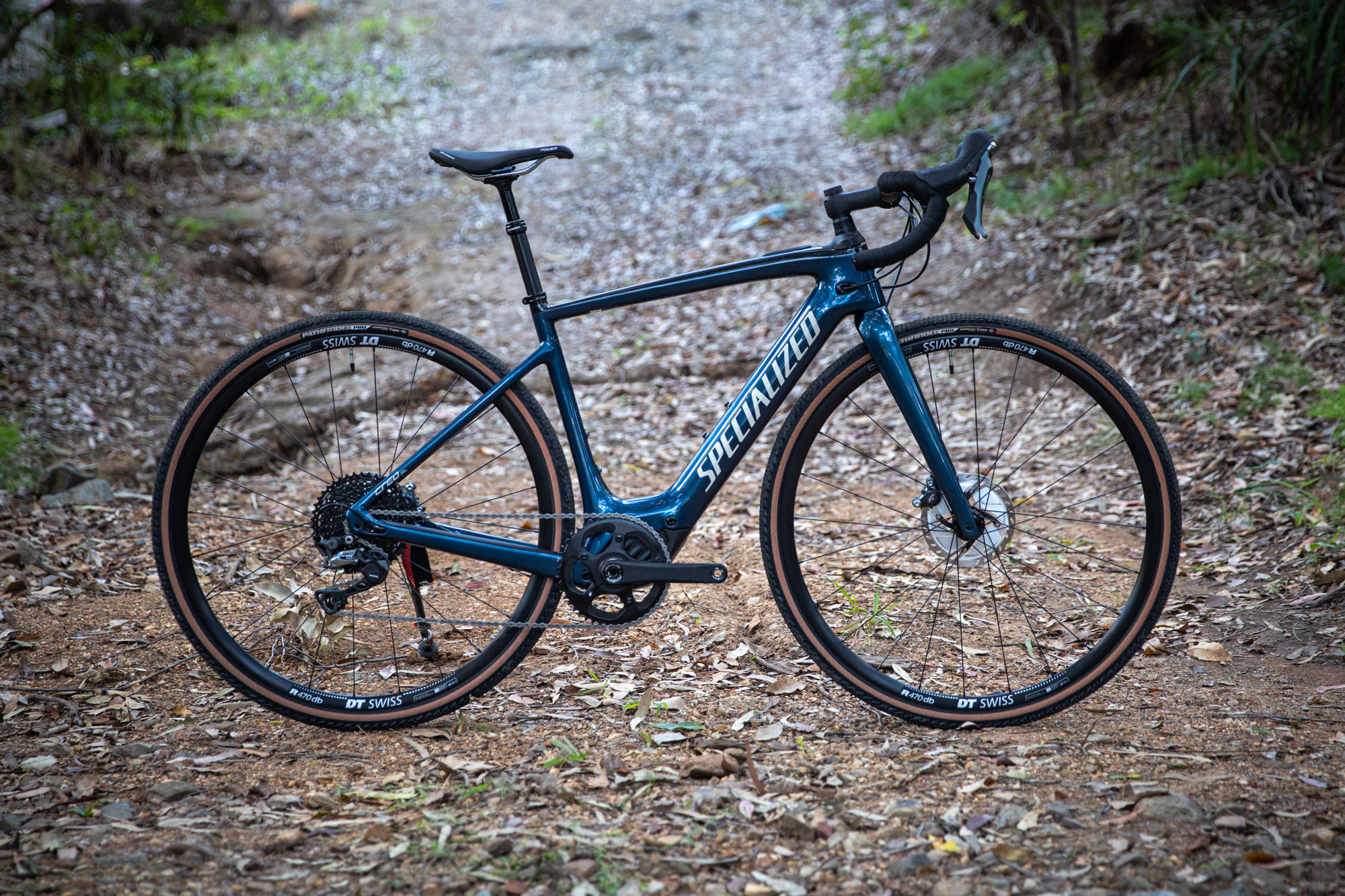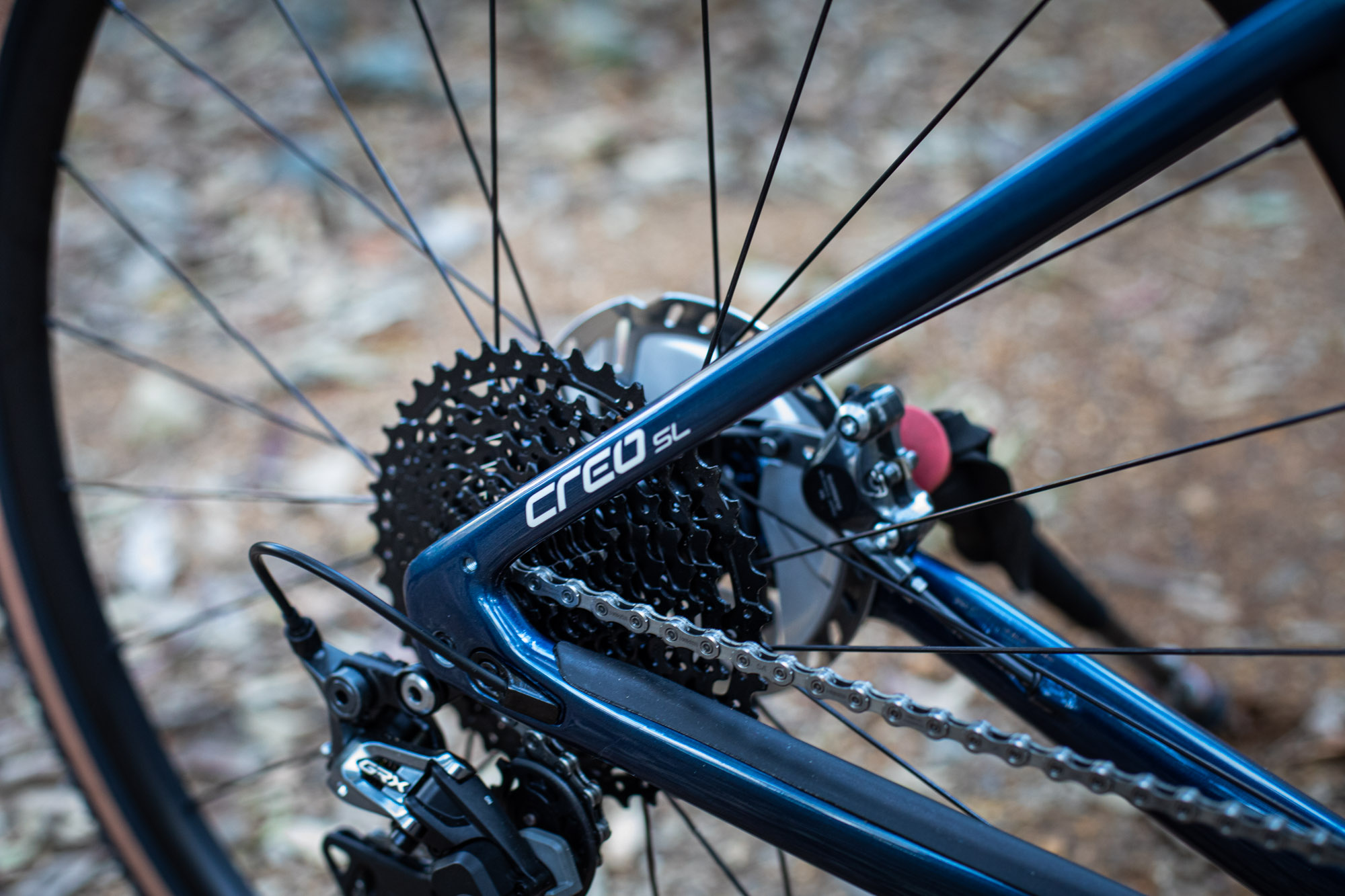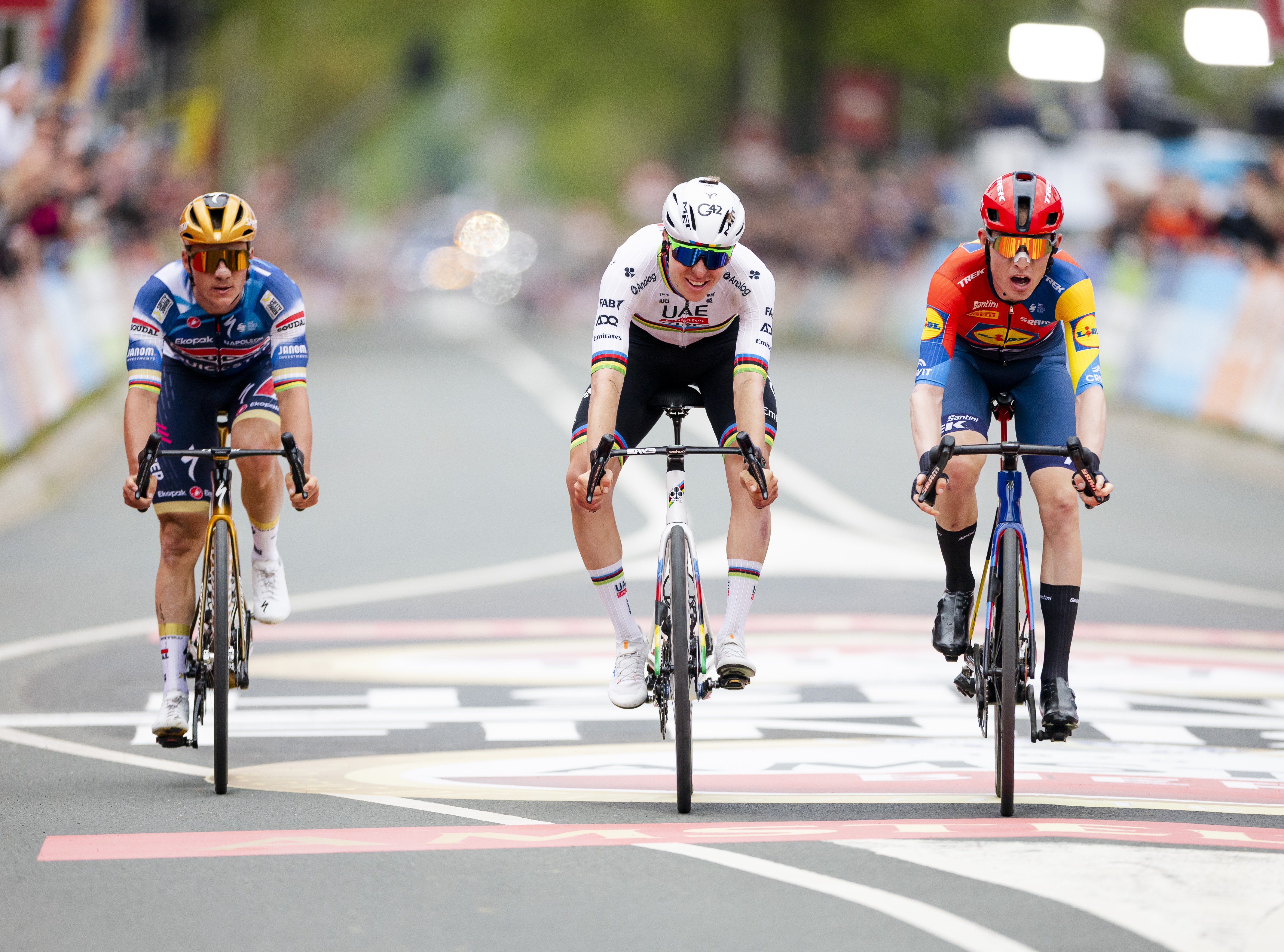Specialized Turbo Creo SL Comp Carbon Evo review
Electrified gravel grinder from Morgan California

To me, Specialized’s Turbo Creo SL Comp Carbon Evo is an ebike that is doing its best impression of a regular bike, and a believable one at that. Whether you’re cursing along above the cutoff speed or riding with the motor off along a flat road, it doesn’t have the lumbering ride quality many ebikes do. When you do hit the power button, the way the motor reacts to your input feels perfectly integrated into the system and natural. It’s comfortable and well mannered and a ball of fun to ride.
-
+
SL1.1 motor
-
+
Weight
-
+
Dropper post
-
-
Praxis front chainring
You can trust Cycling Weekly.
Specialized was early to jump on the electrified drop-bar bike trend, and the Turbo Creo SL Comp Carbon Evo (say that ten times fast) is the brand’s e-gravel offering. Pitched as the lightest e-bike in its class, Specialized opted to design its own e-bike system rather than bolt-on a Bosch or Shimano motor.
Based around the same Fact11 Carbon frame as the S-Works Turbo Creo SL road e-bike we tested last year, the American outfit has capitalized on the space between the chainstays and fork to wack on a set of knobby tyres. It's also bolted on a few adventure-ready parts. But, is this enough to transform a performance road bike into a gravel shredder?
Frame
When I say the frame is the same as the road fairing S-Works Turbo Creo SL, I mean it’s identical — other than the paint, of course. The geometry charts mirror one another, and the Turbo Creo's numbers fall about halfway between the brand's Roubaix endurance bike and Diverge gravel bike.
My size medium tester sees a 379mm reach, 592mm stack, 72.5-degree head angle, and 1012mm wheelbase. The numbers are all roughly what you’d expect to see for a cable multi-surface road bike; however, the 78mm BB drop is the key metric here, falling exactly halfway between the Roubaix and the Diverge. What BB drop creates a low center of gravity and that 'in the bike instead of on top of it' feeling, which creates stability at any speed. Combine this with the long wheelbase and slack-ish front end, and you have a bike that wants to keep its composure when things get spicy.

Smoothly integrated into the bottom bracket is Specialized’s proprietary SL1.1 motor. It is visually more compact than similar options from Bosch and Shimano — including the new EP8 motor — and is claimed to weigh 1.95kg. All in, the Turbo Creo Comp Carbon Evo tipped my scales at 13.86kg, sans pedals and bottle cages.
The final piece of note about the frame and fork is the boost hub spacing. The bike sees a 12x110mm axle at the front and 12x148mm at the rear. This stiffens everything up to better handle the forces from the overall weight of the bike and the motor and pushes the chain line out wider than a non-boost rear-end. The result is space for larger tyre and chainring clearance without the need to blow out the chainstay length — which measures 426mm. Specialized says the Turbo Creo SL Comp Carbon Evo has room for up to 700x42mm (38mm with fenders) or a 650x1.8in tyre.
Motor
The motor itself can output up 240-watts of assistance, 35nm of torque, all powered by a 320Wh battery that’s hidden inside the downtube. Specialized claim you will get up to 130km / 81miles of range on Eco mode on a full charge. With the riding in my area being quite hilly, I was clocking in closer to 100-110km / 60-68mi of riding in eco mode before the battery cut out completely, which is still pretty darn good. Should you want to keep going, Specialized offers a 160wh range extender that’s said to add 64km / 40mi and fits into a bottle cage.

When the bike comes out of the box, there are three levels of assistance, but this can be totally customized through the Mission Control app. Not only can you adjust the level of oomph you get from the drive unit in each mode, but the app also allows you to create adaptive parameters. The most useful being the ability to set a distance and the level of battery you’d like remaining at the end, the bike will manage its battery usage to ensure you don’t run out of juice.
The feature that provided the most laughs for me was pairing a Bluetooth heart rate monitor and having the motor tailor its assistance to keep you at a specific heart rate — this was great for recovery days.
Even before you start tinkering with how the motor applies its power, it feels different from any other e-bike system I’ve ridden to date. There is none of the whiplash-inducing jerkiness at full assists, like some of the other systems out there. The power comes on in a controlled fashion that feels almost natural — likely due to the comparatively small torque output. Even at full strength, the motor doesn’t overpower your output and feels much more in tune with what your legs are doing.

If you turn the motor off or when you outrun the assist, as determined by your local regulations (25kph/15mph here in Australia, the same in the UK), it doesn't feel like you trying to pedal through a sandpit.
In lieu of a bar-mounted display, the motor is controlled by a small pad integrated into the top tube. There is a power button, an ‘S’ button that cycles through the modes, and a battery indicatory. It’s sleek and straightforward, but the placement means you have to take your hand totally off the bars to use it. Specialized has let us know that the My21 models will feature bar-mounted remotes to change the mode that will be similar to Di2 sprint shifters, which can be retrofitted to the My20 bikes.
Components
To limit the number of batteries you need to keep charged on one bike, Specialized has opted for a 1x11 Shimano GRX mechanical groupset with the long cage derailleur to accommodate the 11–42t Sunrace cassette. This is a clever choice as it saves a bit of cash over the comparable SLX or Deore cassettes with the same range, but doesn’t sacrifice much in terms of shifting performance.

The Sunrace 11–42t cassette offers a ton of range, without sacrificing much in the way of shift quality
At the front is a Praxis 46T single chainring, which provides plenty of range at either end of the speedometer; however, the tooth profile left something to be desired. Instead of the narrow-wide tooth teeth that most other brands use for 1x, Praxis designed what it calls 'Wave tooth profile.' This sees the teeth alternate in alignment applying lateral force to grip the chainlinks, which the brand says allows for debris to be cleared more efficiently and slows wear. The trouble is it doesn’t retain the chain as well. With the clutch on, I still lost the chain a handful of times — even after cranking up the clutch tension.
I am a big fan of the GRX shifters, especially the rubberized coating on the brake levers. The additional purchase is tangible, especially in the wet. Paired with 160mm rotors front and rear, this bike can stop in a hurry.
The rolling stock is a set of DT Swiss R470 Boost, which are finished in 700x38mm Pathfinder Pro 2Bilse Ready rubber, complete with the tan sidewall. They're not lightweight, but they are robust. Even after a few bottom outs while exploring singletrack at ambitiously low tire pressures, they are true as the day they came out of the box, and the bearings still feel smooth. The 20mm inner width and 23mm external width aren’t all that cutting edge; it spread the 38mm wide tires nicely and offered the needed sidewall support for pressures in the low 30s.
Specialized has upped its game when it comes to tyres over the past few years, and the Pathfinder Pros are becoming one of my favorites. The smooth center strip rolls fast on hardpack and tarmac, while the transition tread and shoulder tread ramp for consistent grip across lean angles. The casing is supple and does well to dampen vibrations coming up from the road surfaces, and I didn’t have to pull out a bacon strip, tyre boot or levers through my entire testing period.

Supporting the Specialized Power saddle is an X-Fusion Manic Dropper with 50mm of travel. While I can already hear the audible scoffs — this bike has front suspension too — being able to get the saddle out of the way improves descending control ten-fold.
50mm isn’t much drop, but it’s enough to help you get your weight back in steep terrain, and more importantly, provides additional body-bike separation so you can push that much harder on the shoulder knobs to maintain control around a dusty corner. That said, the X-fusion gravel lever leaves a lot to be desired, it’s mushy, no matter the cable tension and doesn’t provide great ergonomics.
At the front, the Spesh Adventure Gear hover bars are paired to the Future Shock 2.0. The second iteration allows you to adjust dampening via a knob that replaces the top cap — meaning it can be stiffened up over tarmac liaisons and opened when things get rough again. This limits the ability to slam your stem, but the Future shock adds tangible comfort to the front end, and improves front end grip in lose corners too.

Ride
I’ve nicknamed the Specialized Turbo Creo SL Comp Carbon Evo the smile maker — in part because it doesn’t ride like an e-bike. Where I live, the gravel riding that is immediately available to me consists mainly of fire road bashing through terrain that makes a topographic map look like a squiggly mess. These rides are a ball of fun and require you to navigate veritable dirt walls, which usually result in hike-a-bike moments. The Creo doesn’t exactly sail up these inclines, but the extra boost helps winch your way up without putting a foot down. The motor still makes you work, but it just provides that extra little push when you need it.
On the other end, not once through the test period did I feel like the motor was catapulting me into techy sections at warp speed, requiring a handful of brake lever and a big cloud of dust to regain control. The motor does well to control the power when you need it and lets off quickly when you don’t.
Even with the heft (compared to a non-assisted bike, that is), the handling is accurate, and the bike stays surprisingly planted navigating tricky singletrack. Given that this bike retains the same geometry and the road fairing version, only seeing a few changes in components, I was impressed by how well mannered it was when the terrain decidedly wasn’t.
The geometry puts you in a confidence-inspiring position, and being able to get the saddle out of the way when things get rowdy only furthers the control you have over the way the bike behaves — plus, you can almost super tuck still sitting on the saddle.
Value
For the asking price of $6,750 / £5,750 / AU$10,200, it’s not exactly what I would class a budget-friendly, but you are getting quite a lot of technology here. Considering it’s made from Specialized’s top-level carbon, has arguable the most tuneable ebike system on the market and the sum of all the parts, I think the value for money is pretty high — and the smiles per dollar ratio is through the roof.

Thank you for reading 20 articles this month* Join now for unlimited access
Enjoy your first month for just £1 / $1 / €1
*Read 5 free articles per month without a subscription

Join now for unlimited access
Try first month for just £1 / $1 / €1
Get The Leadout Newsletter
The latest race content, interviews, features, reviews and expert buying guides, direct to your inbox!
-
 'The line was 5 metres too far' - Tadej Pogačar reacts to Amstel Gold Race second place
'The line was 5 metres too far' - Tadej Pogačar reacts to Amstel Gold Race second placeWorld champion reeled back and beaten in sprint by Lidl-Trek's Mattias Skjelmose
By Tom Davidson Published
-
 'I was riding for the podium' - Mattias Skjelmose pulls off shock Amstel Gold Race win after reeling back Tadej Pogačar attack
'I was riding for the podium' - Mattias Skjelmose pulls off shock Amstel Gold Race win after reeling back Tadej Pogačar attackDane worked with Remco Evenepoel to set up stunning three-way finale
By Tom Davidson Published
-
 'All or nothing' - Mischa Bredewold wins Amstel Gold Race with stinging late attack
'All or nothing' - Mischa Bredewold wins Amstel Gold Race with stinging late attackDutchwoman takes first big Classics win of her career
By Tom Davidson Published